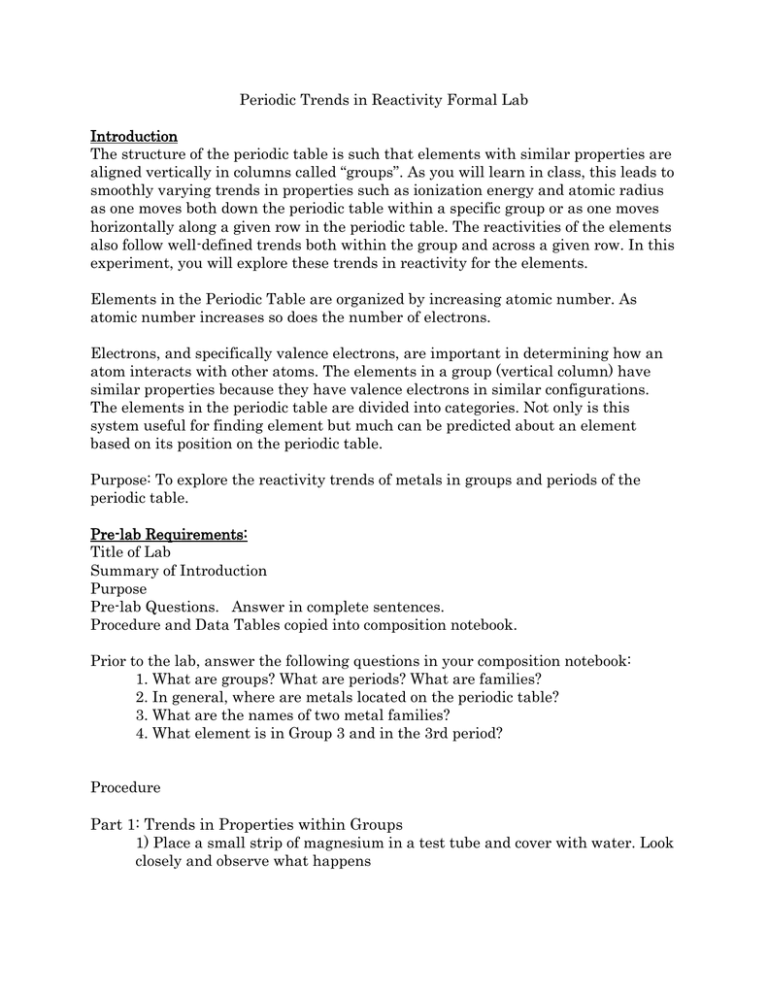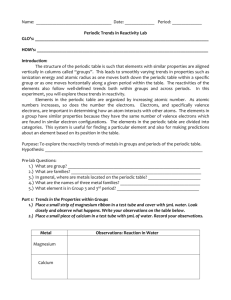Reactivity of Metals Formal Lab
advertisement

Periodic Trends in Reactivity Formal Lab Introduction The structure of the periodic table is such that elements with similar properties are aligned vertically in columns called “groups”. As you will learn in class, this leads to smoothly varying trends in properties such as ionization energy and atomic radius as one moves both down the periodic table within a specific group or as one moves horizontally along a given row in the periodic table. The reactivities of the elements also follow well-defined trends both within the group and across a given row. In this experiment, you will explore these trends in reactivity for the elements. Elements in the Periodic Table are organized by increasing atomic number. As atomic number increases so does the number of electrons. Electrons, and specifically valence electrons, are important in determining how an atom interacts with other atoms. The elements in a group (vertical column) have similar properties because they have valence electrons in similar configurations. The elements in the periodic table are divided into categories. Not only is this system useful for finding element but much can be predicted about an element based on its position on the periodic table. Purpose: To explore the reactivity trends of metals in groups and periods of the periodic table. Pre-lab Requirements: Title of Lab Summary of Introduction Purpose Pre-lab Questions. Answer in complete sentences. Procedure and Data Tables copied into composition notebook. Prior to the lab, answer the following questions in your composition notebook: 1. What are groups? What are periods? What are families? 2. In general, where are metals located on the periodic table? 3. What are the names of two metal families? 4. What element is in Group 3 and in the 3rd period? Procedure Part 1: Trends in Properties within Groups 1) Place a small strip of magnesium in a test tube and cover with water. Look closely and observe what happens 2) Place a small piece of calcium in a test tube with several milliliters of water. Record your observations. Part 2: Activity Series of Some Metals in HCl 1) Obtain a small sample of zinc and tin. You may reuse the Mg from Part 1. Dump out the water from the test tube containing the magnesium but keep the magnesium in the test tube. 2) Place each metal sample in a separate tube. 3) Add a small amount of dilute HCl to each test tube, just enough to cover the sample. Record your observations. Analysis Questions: 1. What can you conclude about the reactivity of metals as you move down a column or group in the periodic table? 2. What can you conclude about the reactivity of metals as you move across a period? 3. Arrange each set of the following metals in order from least to most reactive using conclusions you just made. Set 1: Fr, Na, Cs Set 2: Rb, Ga, Fr 4. Which is the most reactive metal in the periodic table? Explain. Would you expect this metal to be found in its unreacted elemental form? Explain. 5. The following is a reactivity chart found on in the Internet. Do your results and conclusion agree with the information found on this chart? Conclusions: 1) List the four metals from most reactive to least reactive. Use data from your lab to support your answer. 2) In general, is there a relationship between the locations of metals on the Periodic Table and their relative activity? Explain why.



